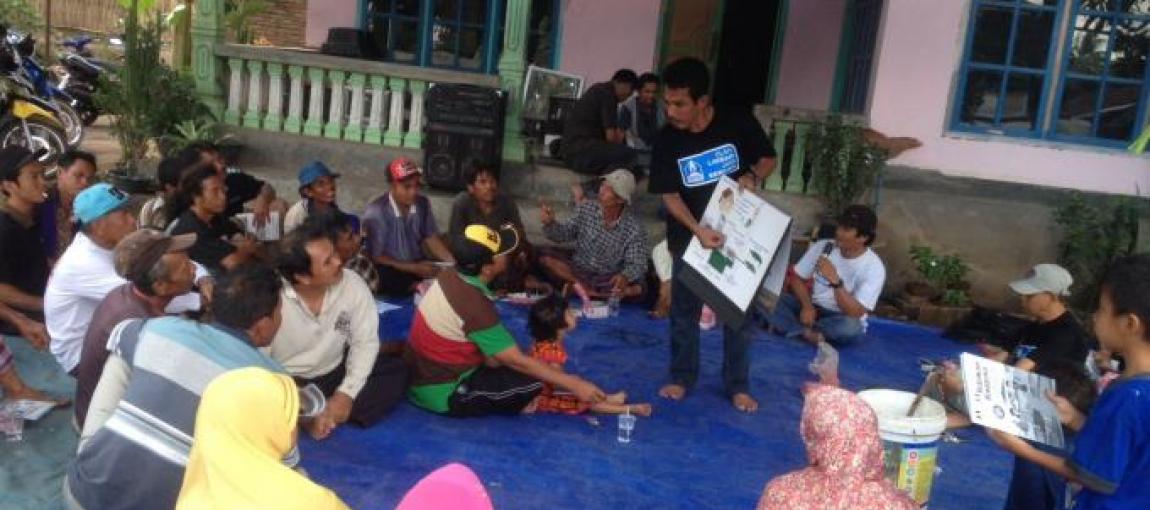
pengetahuanhijau.com - Following our participation in Gading Senggigi Socialisation Programme, that evening (September 26, 2016) we received information on the User Training and Bioslurry Training activities organised by Hivos-Yayasan Rumah Energi (YRE) Consortium through TERANG Programme. Obviously we will not let such opportunity to pass by. Therefore, we hurriedly left the activities in Senggigi region and headed to a Hamlet at the foot of Mount Rinjani. Bile Kembar is the name of the place, one of the hamlet situated in Suela Village, Suela Subdistrict, East Lombok Regency. In order for us to reach the hamlet, we had to travel more than one hundred kilometers from Senggigi. Our initial expectation, we would reach the hamlet within two hours, thus there was still time for us to participate in the activity which was intended for new biogas users. However, beyond our expectation, heavy rain fell on the City of Mataram until the outskirt of East Lombok Regency. Almost all riders reduced the speed of their vehicles as the visibility dropped to less than two meters.
Fortuntely, the rain slowly stopped when we arrived at Suela Subdistrict. Rain drops are still visible in the leaves, nevertheless some children had started to enjoy the remaining rain water in flowing quickly in the gutter by engaging in a boat race game in which they created the boats out of taro leaves. It seemed like they were having fun, chanting and running following their taro leave’s boats down to the finish line. Children’s happiness as well as the greenery along our journey have eliminated the fatigue associated with a fairly long journey. Indeed, Suela Village which is situated at 520 meter above the sea level is blessed with a relatively fertile farmland. The presence of Lemor protected forest is the heart of the life of the surrounding community. Just imagine, there are five spring waters irrigating the rice paddy field as well as the source of drinking water for the inhabitants of Suela Village and the surrounding villages. Additionally, in the protected forest areas, the inhabitants collect the firewood for their daily cooking needs. Shall we consistently disregard these issues, it will eventually negatively impact the sustainability of the protected forest which may ultimately lead to the diminishing ground water discharge in the five spring waters found around the forest.
Taking the conditions into consideration, the local government of East Lombok through the Office of Mining and Energy consistently promote the use of biogas generated by cow manures which have been raised by many local inhabitants. As they receive an equally positive response, the programme has been consistently promoted by Hivos-YRE consortium through TERANG programme funded by Millenium Challenge Account Indonesia (MCA-Indonesia) on a Green Prosperity (GP) project. Hence the local government of the East Lombok which intends to encourage the utilisation of renewable energy resources to preserve the protected forest receives a support from TERANG programme which share the same objectives. The Office of Mining and Energy supports the funding of digester construction while Hivos-YRE performs the advocacies.
The advocacies provided include among othes training on to operte as well as maintain the digester/reactor. In addition to cooking purposes, biogas also holds a remarkable benefit such as for lighting purposes while bio-slurry may be utilised as organic fertilisers and fodder. The environment may be kept clean, household expenditure may be further reduced since there is no longer need to buy kerosene or firewood. Other benefits include more time is available for other productive activities as there are no longer needs to collect firewood, no need to worry about the fluctuated fuel price, safe (explosion risk is eliminated), easy operation, improved health (no risk of Upper Respiratory Tract Infection due to the use of firewood), as well as minimising air pollution due to the Carbondioxide. By using one cubic meter of biogas, we have saved the use of 0.62 liter of kerosene; 0.80 liter of petrol; 0.46 kg of LPG; and 3.5 kg of firewood.
After spending almost three hours on the road, we finally arrived at the training venue. Even though we were late, we still felt the participants’ enthusiasm through questions addressed to the supervisors and Hivos-YRE mason partners which acted as the facilitator during the event. A number of questions regarding the methods of digester maintenance as well as the operation of the biogas reactor were among questions raised by the participants. Participants were new users of biogas reactors. There are 50 newly constructed reactors in Bile Kembar between the month of May through July 2016. It is possible that the quantity will be steadily increasing when we consider the economic values biogas conversion against other sources of energy.
Additionally, the significant benefits enjoyed by the users are beyond the energy aspects but also the bio-slurry with its numerous benefits. Firstly, as a fertiliser and activator. Bio-slurry may be utilised for organic fertiiser, bio-fertiliser, bio-activator, and growth regulator. Secondly, as pesticides, bio-slurry may be utilised as bio-fungicides, bio-insecticides, and seed protector. Thirdly, as fodder. So far, bio-slurry may be processed along with other local feed resources to produce animal feedstuff for chickens, fish, ducks, rabbits, and earthworms. And fourthly, bio-slurry may be utilised as plant culture media in hydroponics as well as media for fungiculture.
TERANG Programme is implemented in Bile Kembar and is expected to serve as learning venues for other hamlets on how to process the animal waste products to a product with a plenty of benefits to improve the family living standard. This program slowly is expected to promote the community awareness on the importance of safeguarding and preserving the environment.
(Source: http://pengetahuanhijau.com/berita/terang-di-bile-kembar)


